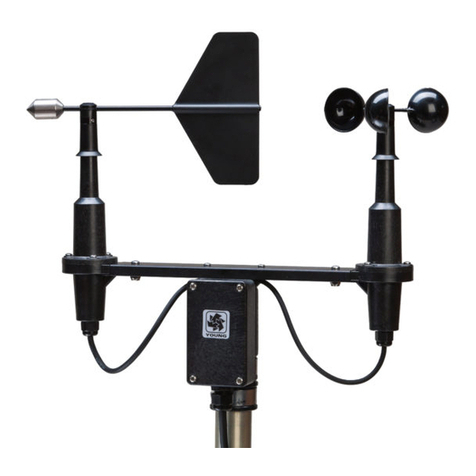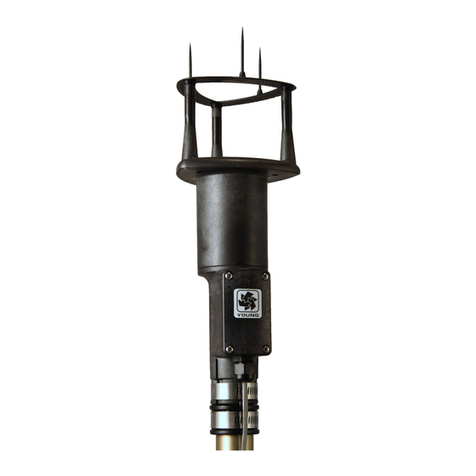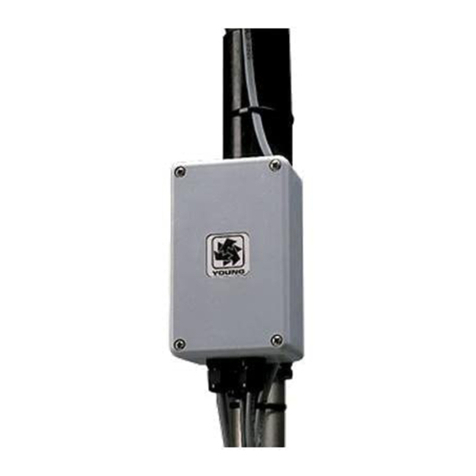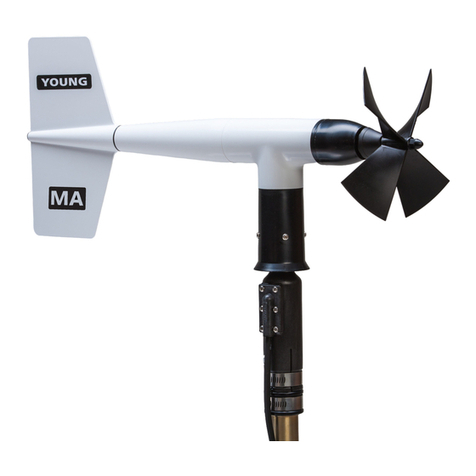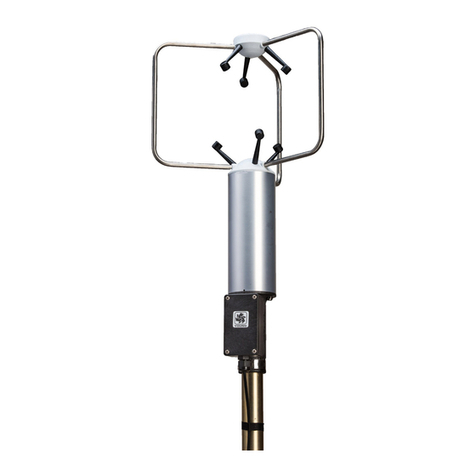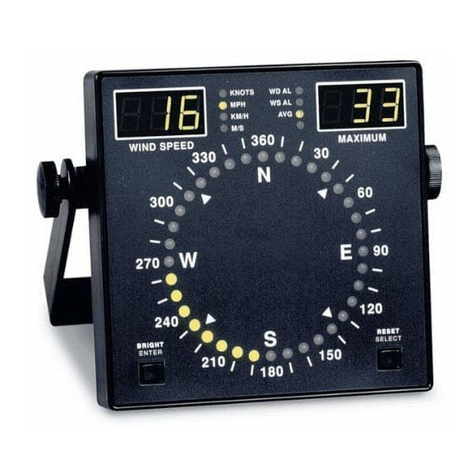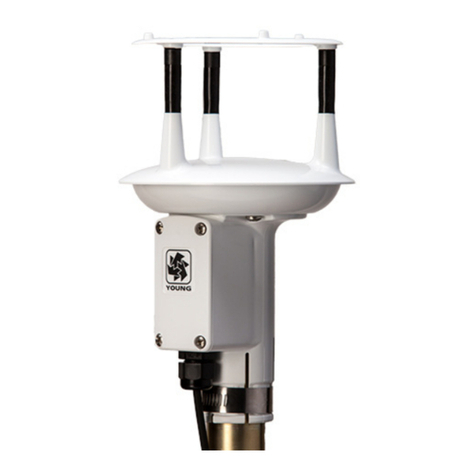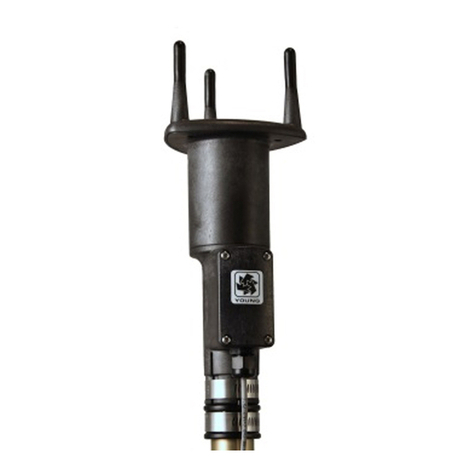
Page 2
03002-90(D)
the height downwind, and twice the height of the structure above
ground. For some observations it may not be practical or necessary
to meet these guidelines.
FAILURE TO PROPERLY GROUND THE WIND SENTRY
MAY RESULT IN ERRONEOUS SIGNALS
OR TRANSDUCER DAMAGE.
Grounding the Wind Sentry is vitally important. Without proper
grounding, static electrical charge can build up during certain
atmospheric conditions and discharge through the transducers.
This discharge can cause erroneous signals or transducer failure.
To direct the discharge away from the transducers, the instrument
is made with a special anti-static plastic. It is very important that
the instrument be connected to a good earth ground. There are
two ways this may be accomplished. First, the Wind Sentry may
be mounted on a metal pipe which is connected to earth ground.
The mounting pipe should not be painted where the Wind Sentry is
mounted. Towers or masts set in concrete should be connected to
one or more grounding rods. If it is difcult to ground the mounting
post in this manner, the following method should be used. Inside
the junction box the terminal labeled EARTH GND is internally
connected to the anti-static housings. This terminal should be
connected to an earth ground (Refer to wiring diagram).
Initial installation is most easily done with two people; one to adjust
the instrument position and the other to observe the indicating
device. When anemometer and vane are mounted on the same
cross arm (Model 03002), the azimuth potentiometer has been
aligned at the factory such that the mounting cross arm should be
oriented North-South with the vane on the North end.
To install the Wind Sentry, follow these steps:
1. MOUNT WIND SENTRY
a) Connect sensor cable to Wind Sentry junction box.
b) Place Wind Sentry on mounting post. Do Not tighten
band clamp yet.
c) Connect sensor cable to indicator.
2. ALIGN VANE
a) Select a known azimuth reference point on the horizon.
b) Sighting down vane centerline, point counterweight at
reference point on horizon.
c) While holding vane in position, slowly turn base until
indicator displays proper value.
d) Tighten mounting post band clamp.
CALIBRATION
The Wind Sentry is fully calibrated before shipment and should
require no adjustments. Recalibration may be necessary after
some maintenance operations. Periodic calibration checks are
desirable and may be necessary where the instrument is used in
programs which require auditing of sensor performance.
For wind direction calibration, the following method can yield an
accuracy of ±5° or better if carefully done. Begin by connecting
the instrument to a signal conditioning circuit which indicates
wind direction value. This may be an indicator which displays
wind direction values in angular degrees or simply a voltmeter
monitoring the output. Hold or mount the instrument so the vane
center of rotation is over the center of a sheet of paper which has
30° or 45° crossmarkings. Position the instrument so the mounting
crossarm is oriented north-south with the vane on the north and the
anemometer on the south. With the counterweight pointing directly
at the anemometer the wind direction signal should correspond
to 180° or due south. Looking from above, visually align the vane
with each of the crossmarkings and observe the indicator display.
It should correspond to vane position within 5°. If not, it may be
necessary to adjust the relative position of the vane skirt and shaft.
See step 3 in the MAINTENANCE section under potentiometer
replacement.
It is important to note that while the sensor mechanically rotates
through 360°, the full scale wind direction signal from the signal
conditioning occurs at 352°. For example, in a circuit where 0 to
1.00 VDC represents 0° to 360°, the output must be adjusted for
0.978 VDC when the instrument is at 352° full scale. (352°/360° X
1.00 volts = 0.978 volts)
Wind speed calibration is determined by the cup wheel turning
factor and the output characteristics of the transducer. Calibration
formulas showing cup wheel rpm and frequency output vs. wind
speed are included below.
To calibrate wind system electronics using an actual signal from
the instrument, temporarily remove the cup wheel and connect an
Anemometer Drive to the cup wheel shaft. Calculate wind speed
by applying the appropriate calibration formula to the motor rpm
and adjust the signal conditioning electronics for proper value. For
example, with the cup wheel shaft turning at 1800 rpm, adjust the
indicator to display 22.7 meters per second. ([(0.01250 X 1800) +
0.2] = 22.7)
CALIBRATION FORMULAS
Model 03102 Wind Sentry Anemometer
WIND SPEED vs CUP WHEEL RPM
m/s = (0.01250 x rpm) + 0.2
knots = (0.02427 x rpm) + 0.4
mph = (0.02795 x rpm) + 0.4
km/hr = (0.04499 x rpm) + 0.7
WIND SPEED vs OUTPUT FREQUENCY - Hz
m/s = (0.7500 x Hz) + 0.2
knots = (1.4562 x Hz) + 0.4
mph = (1.6770 x Hz) + 0.4
km/hr = (2.6994 x Hz) + 0.7
MAINTENANCE
Given proper care, the Wind Sentry should provide years of
service. Because of its durable, corrosion resistant construction,
the instrument requires little maintenance. The only components
likely to require replacement due to normal wear are the precision
ball bearings and the azimuth potentiometer. Replacement
of these components should only be performed by a qualified
instrument technician. If service facilities are not available, return
the instrument to the factory. Refer to the accompanying drawings
to become familiar with part names and locations. Maximum torque
on all set screws is 80 oz-in.
POTENTIOMETER REPLACEMENT
The potentiometer has a life expectancy of fty million revolutions.
As it becomes worn, the element may produce noisy signals or
become non-linear. When the signal noise or non-linearity become
unacceptable, replace the potentiometer as follows:
1. REMOVE POTENTIOMETER
a) Remove three screws which secure upper and lower sections
of main housing.
b) Carefully remove upper housing exposing wiring connections
to circuit board.
c) Unsolder potentiometer wires from circuit board. Note color
code.
d) Using a knife blade or similar instrument, loosen potentiometer
assembly from upper housing and slide it out.


